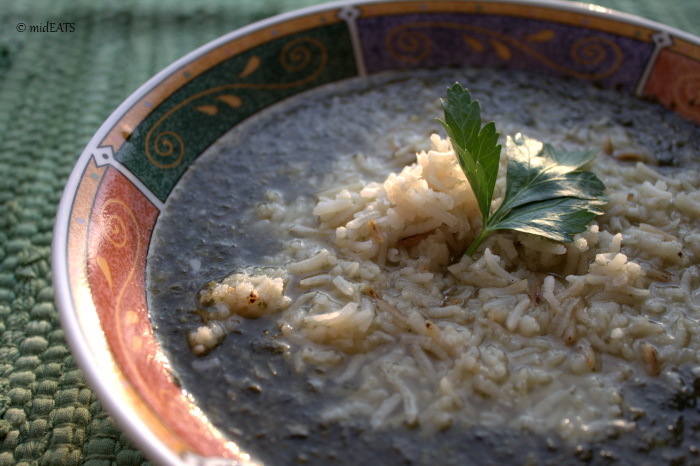Molokhia– a green soup eaten ‘by ancient kings’ – have you heard of it? Most likely, if you’re not Middle Eastern, you have no idea what I’m talking about. Egyptians in particular love it! Curious yet? Molokheya (other spellings include molokheya or mulukhiya) is a dark leafy green plant that looks similar to spinach but tastes very different, and unlike any other vegetable that I’ve personally come across. Apparently, the Arabic name of the dish, molokhia, is a derivative of the word mulukiya – which literally means ‘kingly’, or “of the kings.” My superb Googling research revealed that molokhia was actually an ancient Egyptian staple eaten only by kings and nobles, er, pharaohs. Today, obviously Egypt doesn’t have many kings, and fortunately for us commoners, molokhia is now widely eaten by anyone who can make it to the local store, so all those leaves don’t have to go to waste! In fact, it’s considered a national dish by some, right up there with ful medammes and koshary.
Prep Time: 10 minutes Cook Time: 1 Hour Serves: 5 – 6 servings
Ingredients
- 1 packet of frozen or a little less than 1 lb. fresh finely chopped molokhia leaves (Frozen molokhia found in most Middle Eastern stores is almost always sold finely chopped, but double check the package to make sure)
- 1 whole pastured chicken (As mentioned above, you can also use duck, rabbit or wild shrimp to make molokhia – the duck’s broth is an exceptional one. The others I haven’t made yet.)
- Several cups of filtered water to cover the chicken while cooking on the stove
- 1 yellow onion, cut in fourths
- 10 garlic cloves, minced
- 1 tablespoon of grass-fed ghee or pastured butter
- 1 tablespoon ground coriander
- 1 tablespoon fresh lemon juice
- 2-3 bay leaves, broken into pieces
- 4-5 cardamom pods, crushed to release flavor
- Unrefined salt and freshly ground black pepper, to taste
Instructions
- Make the base broth(some of which will be used to make the molokehya stew): Rinse the chicken under running water, rub with salt, rinse well, and place in a deep stainless steel pot. Add enough filtered water to cover the chicken and set on high heat. Add onion (chopped in fourths), bay leaves, cardamom pods, salt and pepper to the boiling chicken. Lower to medium heat and cook for 40 min to an hour (depending on chicken weight), until chicken is fully cooked and has reached an internal temperature of 190F.
- Roast the chicken: Remove the cooked chicken and place it in a baking dish. Add a tablespoon of ghee, and your herbs or spices of choice, spread it on the chicken, and broil in the oven for 10-12 minutes on a temperature of 400F until golden brown, flipping the chicken on the other side to roast midway.
- Make the garlic-coriander mixture:Using a mortar and pestle or a handheld electric grinder, mince 10 cloves of garlic. In a separate pot, melt 1 tablespoon of butter or ghee and add the crushed garlic. Add 1 tablespoon of ground coriander and a few drops of lemon juice to the garlic. Sauté the mixture for 2 minutes or until a little browned.
- Mix it all together: Add 8-10 cups of the freshly made chicken broth to the garlic-coriander mixture. Simmer for 2 minutes. Try to break the molokhia (if frozen) into a few pieces first, then add them to the soup, stirring continuously to break up the frozen pieces. If using fresh leaves, simply drop the minced leaves into the broth and stir. Boil only for about 5 minutes until the molokhia is well mixed. Make sure not to overcook or keep boiling as molokhia needs to be suspended (overcooking makes the leaves fall to the bottom).
- Many people add white rice to the molokhia, and some add crushed pieces of toasted pita bread. Others, like my grandma, would add the roasted chicken or duck, cut up into pieces into the molokhia. Personally, I now do neither. If I have rice, I only add a spoonful. And I enjoy the roasted bird or meat on the side, to better savor the flavors individually. But of course, there is no rule about how to eat molokhia – it is a matter of preference and tradition! In any case, the only rule is to savor every bite and to eat it while hot, because the flavor of molokhia is unparalleled.
( source: http://mideats.com/molokheya/ )




No comments yet, be the first to leave one!
You must be logged in to post a comment.